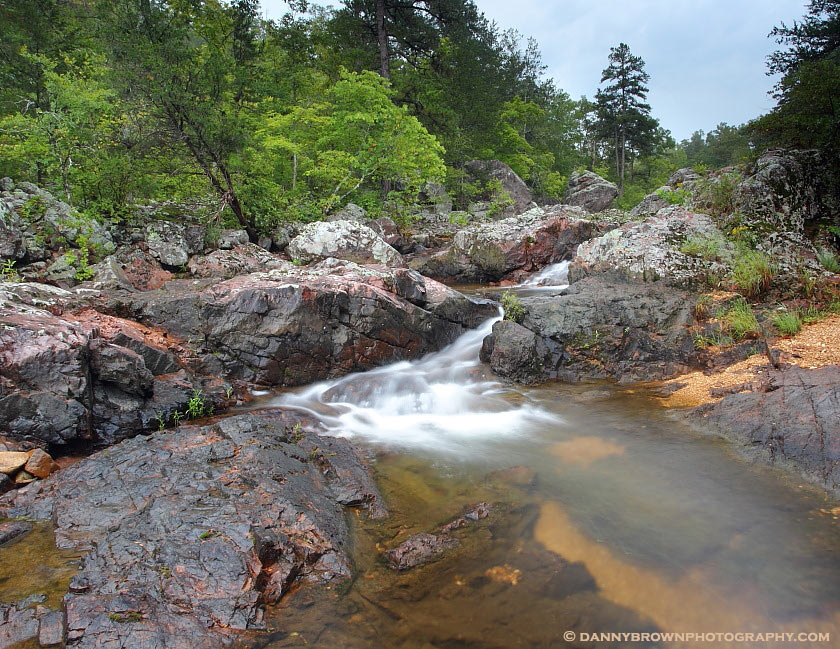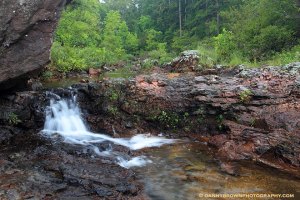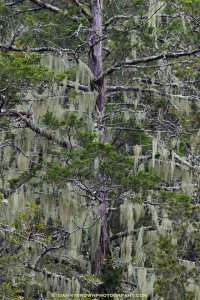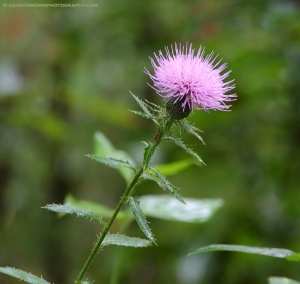
Mill Mountain Natural Area……via Pulltite Spring
By: Danny Brown
Tags: Danny Brown, Mill Mountain Natural Area, Missouri, Nature Frames, nature photography, Ozark Trail, Pulltite Spring
Category: Landscapes
The shut-ins of Mill Mountain Natural Area are featured this week, but my original plan was to photograph Pulltite Spring on the Current River. I set the alarm for 3:00 a.m. on Sunday morning and was in bed by 10:30. I had already loaded my truck with my kayak and most of my camera equipment so I wouldn’t have to dally around before my departure. The alarm went off 10 seconds after my head hit the pillow, or so it seemed. I jumped into my swimming trunks and wading shoes and headed west on I-44 for Pulltite Campground.
I arrived at Pulltite Access just before daylight and the river was flowing briskly under a heavy layer of fog. I didn’t dare launch my kayak because I didn’t want to end up sideways against a hidden log or rock and lose my camera equipment. Also, I’d never been to Pulltite so I didn’t know specifically where to find the entrance to the spring. I only knew that it was on the other side of the river.
I sat on the tailgate of my truck for awhile until I finally saw a couple of campers getting ready for breakfast. I asked them about the spring and they advised me that it was down river near the end of the campground. If I used my kayak to access the spring, I would have to paddle through at least three riffles and then get myself back upstream to the boat ramp. A few minutes later, a park worker advised me that it would be easier to drive to the end of the campground and wade across the river to the spring’s trailhead, a recommendation that I later found to be much easier said than done.
I found a place to park at the lower end of the campground and grabbed my camera backpack and tripod. As I began my bushwhack through the thick riparian corridor, my bare legs became quite an attraction to stinging nettle and horseflies. I was off to a rough start. When I finally made it to river’s edge, I saw some campers on the other side near the spring outfall. They suggested I try to portage across the riffle upstream from their camp. A better idea would have been for them to cross the river with one of their canoes and give me a ride to the other side. I didn’t ask and they didn’t offer.
I trudged upstream through some more stinging plants and insects and finally made it to the riffle. As I said earlier, the Current River was pretty feisty that morning so after a few steps into the water, the bottom of my camera pack was already getting wet. I stood there for a moment and thought, “Don’t walk yourself into an exciting story about how you lost all your camera gear in the Current River!” I turned around and headed back through the brush to my truck. Just as I opened the door to stow my gear the sky opened with a deluge that lasted for the next hour. I had made a good decision to turn back!
I headed south to Eminence with a plan to photograph an alternate site—Mill Mountain Natural Area. By the time I arrived at the trailhead, the kayak in the bed of my pickup was already half-full of water but the rain was beginning to let up. I sat in my truck until the rain diminished to a drizzle, grabbed my gear and hopped onto a short section of the Ozark Trail that would take me to the Mill Mountain shut-ins. I’d photographed the nearby Klepzig Mill shut-ins and Rocky Falls in previous years but this would be my first look at the more remote Mill Mountain section.
I began my walk through an old field and soon I was surrounded by the colorful igneous glade that Don Kurz described in his Missouri’s Natural Wonders Guidebook. It wasn’t long before I could hear the call of the shut-ins—rapids winding their way through purple boulders of rhyolite bedrock. I arrived at the site a few minutes later and I was taken by its beauty.
The featured image of this post conveys the overall look of the shut-ins at Mill Mountain Natural Area. You can see how Rocky Creek winds through the lichens-covered boulders forming whimsical waterfalls along the way. I’ve been to several similar sites but I never grow tired of seeing new examples of Missouri’s beautiful shut-in reaches of water and rock.
My second image is a bit tighter and it shows a typical drop as the creek meanders toward the Current River, only three miles away. Also, notice in the second image how lush and verdant the summer vegetation looks in contrast to the colorful rock formations. As much as I love to photograph landscapes in autumn, I also appreciate the unique beauty of Missouri’s water features during summer. Wow…I just said something nice about summer. Don’t tell my friends. 🙂
Another feature of Mill Mountain Natural Area is the presence of a lichens, called Old Man’s Beard, that hangs from the branches of cedar trees along the shut-ins. Reminiscent of Spanish moss, the lichens thrives at this location. According to the aforementioned guidebook, Indians used the lichens, which contains natural antibiotics, as a compress to fight infections in battle wounds. I did my best to get an image of a cedar draped in Old Man’s Beard but it was a challenge. As always, I recommend that you go and see it for yourself.
Finally, on my way out of Mill Mountain Natural Area, I ran across a plant that I don’t see too often during my adventures—native thistle. Much cleaner looking than the introduced bull thistle I’m used to seeing, I had to share an image of my find with you. I presume it is tall thistle, by the way. I hope the goldfinches make use of tall thistle as much as they do the exotic bull thistle.
If you ever take a trip to Mill Mountain Natural Area, don’t forget to stop at Rocky Falls on your way. It is only a few miles away and features a 40-foot waterfall that cascades over an igneous rock face. Many consider Rocky Falls to be Missouri’s most impressive waterfall. It is also an amazing swimming hole if you happen to visit it on a hot summer day. One of these days I’ll tell you the story of how I almost lost my camera gear below Rocky Falls. After slipping off a ledge, I actually found myself swimming in 10 feet deep water while holding my tripod and camera above my head…..yikes!
I suppose Missouri’s natural wonders will always be a challenge to those of us who feel a need to share them through our lenses. The effort is part of the reward.
Thanks for looking,
DB
********************************************
Mill Mountain Shut-ins: Canon 1D Mark IV; Canon 17-40 L Lens; 3.2 seconds @ f/18; ISO 400 (Whoops); B + W Circular Polarizer; Lee Graduated Neutral Density Filter (4 x 6) 0.9 hard edge; RAW Capture; Feisol CT3301 Carbon Fiber Tripod with Markins M-10 Ballhead; Converted and Processed in Canon DPP
Mill Mountain Shut-ins: Canon 1D Mark IV; Canon 17-40 L Lens; 1/5 @ f/8; ISO 400 (Whoops); B + W Circular Polarizer; Lee Graduated Neutral Density Filter (4 x 6) 0.9 hard edge; RAW Capture; Feisol CT3301 Carbon Fiber Tripod with Markins M-10 Ballhead; Converted and Processed in Canon DPP
Old Man’s Beard in a Cedar Tree: Canon 1D Mark IV; Canon 300/4 L IS Lens; 1/80 @ f/5.6; ISO 400 (Whoops); RAW Capture; Feisol CT3301 Carbon Fiber Tripod with Markins M-10 Ballhead; Converted and Processed in Canon DPP
Native Thistle: Canon 1D Mark IV; Canon 300/4 L IS Lens; 1/5 @ f/11; ISO 400 (Whoops); RAW Capture; Feisol CT3301 Carbon Fiber Tripod with Markins M-10 Ballhead; Converted and Processed in Canon DPP




Beautifully related story Danny….your words bring me (the reader) right into your world…but you want me to travel through all that brush and bugs to see these things…I think NOT….instead I count on you to go and bring me your beautiful pictures and inspiring words….loved this story and fear for you and what you go through to get your story….what determination and guts you have….thanks for doing what you do….Jessee
Thanks Jessee,
I make it sound a lot worse than it really is. Always great to hear from you and know that your are enjoying the stories and photos.
DB
Good decision to run around. It’s nice to be able to see all that clearly in hindsight.
You are right about that Lyle. Take care.
Interesting post this week, Danny. Great stories to go along with great photography! Thanks for sharing your talent and your passion of Missouri’s outdoors with all of us!
Your are welcome Brenda. I’m heading to western Missouri this week. Maybe I’ll get something out there.
I stumbled onto your post by searching stinging plants at Pulltite Spring. We visited the river for kayaking for the first time today. I would have loved to see the spring but on the way back to it, my legs were stinging and my foot blistered up. I haven’t ever encountered anything like that. Do you know specifically what types of plants that may have caused that?
Sorry to hear that Monica. Sounds like stinging nettle. Very common along the rivers. Usually the pain and itching go away pretty quick. Sounds like you are extra sensitive. Hope you fell better.